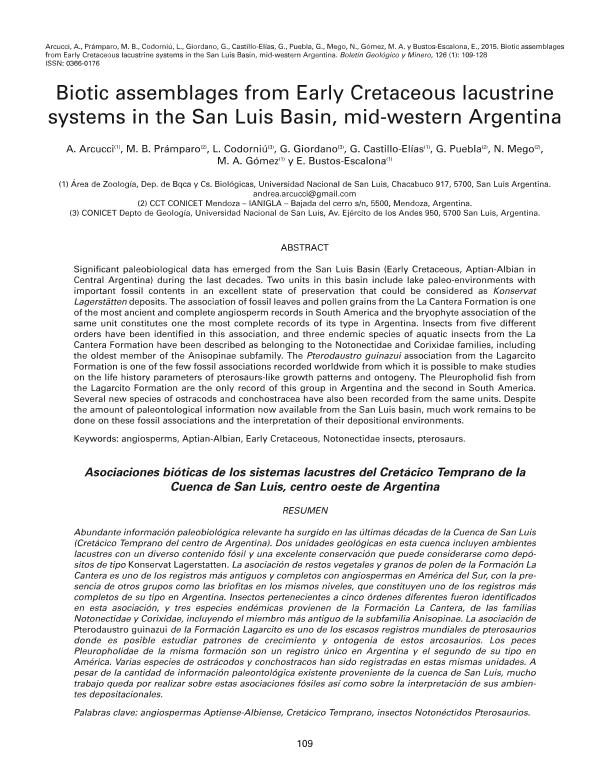Artículo
Significant paleobiological data has emerged from the San Luis Basin (Early Cretaceous, Aptian-Albian in Central Argentina) during the last decades. Two units in this basin include lake paleo-environments with important fossil contents in an excellent state of preservation that could be considered as Konservat Lagerstätten deposits. The association of fossil leaves and pollen grains from the La Cantera Formation is one of the most ancient and complete angiosperm records in South America and the bryophyte association of the same unit constitutes one the most complete records of its type in Argentina. Insects from five different orders have been identified in this association, and three endemic species of aquatic insects from the La Cantera Formation have been described as belonging to the Notonectidae and Corixidae families, including the oldest member of the Anisopinae subfamily. The Pterodaustro guinazui association from the Lagarcito Formation is one of the few fossil associations recorded worldwide from which it is possible to make studies on the life history parameters of pterosaurs-like growth patterns and ontogeny. The Pleuropholid fish from the Lagarcito Formation are the only record of this group in Argentina and the second in South America. Several new species of ostracods and conchostracea have also been recorded from the same units. Despite the amount of paleontological information now available from the San Luis basin, much work remains to be done on these fossil associations and the interpretation of their depositional environments. Abundante información paleobiológica relevante ha surgido en las últimas décadas de la Cuenca de San Luis (Cretácico Temprano del centro de Argentina). Dos unidades geológicas en esta cuenca incluyen ambientes lacustres con un diverso contenido fósil y una excelente conservación que puede considerarse como depósitos de tipo Konservat Lagerstatten. La asociación de restos vegetales y granos de polen de la Formación La Cantera es uno de los registros más antiguos y completos con angiospermas en América del Sur, con la presencia de otros grupos como las briofitas en los mismos niveles, que constituyen uno de los registros más completos de su tipo en Argentina. Insectos pertenecientes a cinco órdenes diferentes fueron identificados en esta asociación, y tres especies endémicas provienen de la Formación La Cantera, de las familias Notonectidae y Corixidae, incluyendo el miembro más antiguo de la subfamilia Anisopinae. La asociación de Pterodaustro guinazui de la Formación Lagarcito es uno de los escasos registros mundiales de pterosaurios donde es posible estudiar patrones de crecimiento y ontogenia de estos arcosaurios. Los peces Pleuropholidae de la misma formación son un registro único en Argentina y el segundo de su tipo en América. Varias especies de ostrácodos y conchostracos han sido registradas en estas mismas unidades. A pesar de la cantidad de información paleontológica existente proveniente de la cuenca de San Luis, mucho trabajo queda por realizar sobre estas asociaciones fósiles así como sobre la interpretación de sus ambientes depositacionales.
Biotic assemblages from Early Cretaceous lacustrine systems in the San Luis Basin, mid-western Argentina
Título:
Asociaciones bióticas de los sistemas lacustres del Cretácico Temprano de la Cuenca de San Luis, centro oeste de Argentina
Arcucci, Andrea Beatriz; Pramparo, Mercedes Beatriz ; Codorniú Dominguez, Laura Susana
; Codorniú Dominguez, Laura Susana ; Giordano, Paula Guillermina
; Giordano, Paula Guillermina ; Castillo Elías, Gabriela
; Castillo Elías, Gabriela ; Puebla, Gabriela Griselda
; Puebla, Gabriela Griselda ; Mego, Natalia
; Mego, Natalia ; Gomez, Maria Angelica
; Gomez, Maria Angelica ; Bustos Escalona, Evelyn Luz
; Bustos Escalona, Evelyn Luz
 ; Codorniú Dominguez, Laura Susana
; Codorniú Dominguez, Laura Susana ; Giordano, Paula Guillermina
; Giordano, Paula Guillermina ; Castillo Elías, Gabriela
; Castillo Elías, Gabriela ; Puebla, Gabriela Griselda
; Puebla, Gabriela Griselda ; Mego, Natalia
; Mego, Natalia ; Gomez, Maria Angelica
; Gomez, Maria Angelica ; Bustos Escalona, Evelyn Luz
; Bustos Escalona, Evelyn Luz
Fecha de publicación:
03/2015
Editorial:
Instituto Geológico y Minero de España
Revista:
Boletín Geológico y Minero
ISSN:
0366-0176
Idioma:
Inglés
Tipo de recurso:
Artículo publicado
Clasificación temática:
Resumen
Palabras clave:
Angiosperms
,
Aptian-Albian
,
Early-Cretaceous
,
Notonectidae Insects
Archivos asociados
Licencia
Identificadores
Colecciones
Articulos(CCT - SAN LUIS)
Articulos de CTRO.CIENTIFICO TECNOL.CONICET - SAN LUIS
Articulos de CTRO.CIENTIFICO TECNOL.CONICET - SAN LUIS
Articulos(IANIGLA)
Articulos de INST. ARG. DE NIVOLOGIA, GLACIOLOGIA Y CS. AMBIENT
Articulos de INST. ARG. DE NIVOLOGIA, GLACIOLOGIA Y CS. AMBIENT
Citación
Arcucci, Andrea Beatriz; Pramparo, Mercedes Beatriz; Codorniú Dominguez, Laura Susana; Giordano, Paula Guillermina; Castillo Elías, Gabriela; et al.; Biotic assemblages from Early Cretaceous lacustrine systems in the San Luis Basin, mid-western Argentina; Instituto Geológico y Minero de España; Boletín Geológico y Minero; 126; 3-2015; 109-128
Compartir



